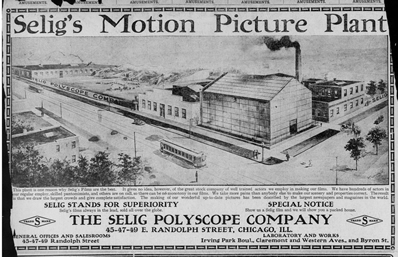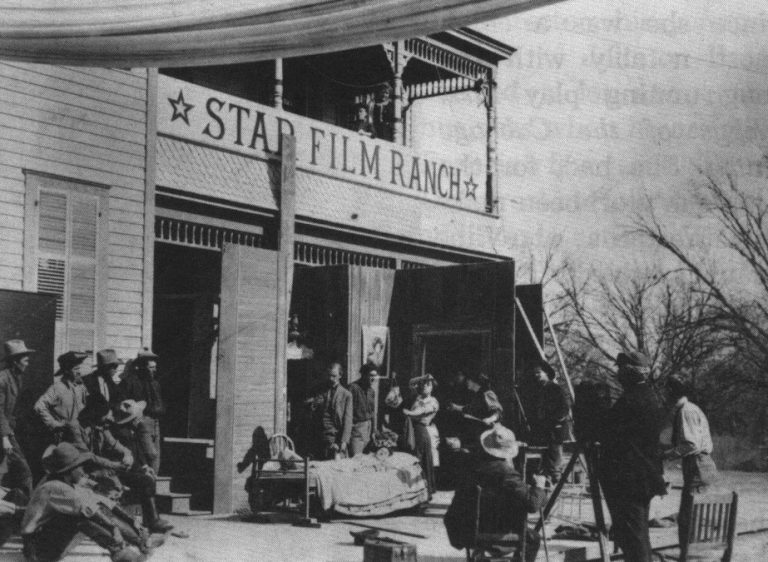Film Exchanges
 Edison wanted to sell equipment and films but theater owners really needed a lot of films. People always wanted to see new films. This was a problem for theater owners who bought films.
Edison wanted to sell equipment and films but theater owners really needed a lot of films. People always wanted to see new films. This was a problem for theater owners who bought films.
Theater owners began to set up film exchanges: rental services that provided films to theaters, generally by the foot.
Once the theaters and exchanges were established, some owners took the next logical step: make the film themselves, cutting out Edison and similar companies.
Next: new moguls
 In the late 90s and 00s Edison and Eastman tried but failed to
control the growing movie industry. Over 500 legal actions were taken
as movie makers sued each other. Companies hired thugs to destroy each others' equipment. In 1908 these disputes were temporarily solved when the nine leading film companies formed the MPPC (the Motion Picture Patents Corporation, often called The Edison Trust, or just The Trust). The MPPC tried prevent any additional companies from entering the film industry.
However, the MPPC failed rapidly and by 1918 not only had the Trust disappeared, but virtually all of its individual members were gone.
In the late 90s and 00s Edison and Eastman tried but failed to
control the growing movie industry. Over 500 legal actions were taken
as movie makers sued each other. Companies hired thugs to destroy each others' equipment. In 1908 these disputes were temporarily solved when the nine leading film companies formed the MPPC (the Motion Picture Patents Corporation, often called The Edison Trust, or just The Trust). The MPPC tried prevent any additional companies from entering the film industry.
However, the MPPC failed rapidly and by 1918 not only had the Trust disappeared, but virtually all of its individual members were gone.
 Here's what happened to most of the original members of the MPPC: Edison Studios closed 1918. Biograph dissolved 1915. Lubin was acquired by Vitagraph in 1916 Kalem was acquired by Vitagraph in 1917. Essanay and Selig were was acquired by Vitagraph 1918 (the Selig lot became a zoo). Despite these acquisitions, Vitagraph continued to decline and was eventually bought by Warner Bros in 1925. Star (owned by Méliès brothers) was sold to General Film 1917 which was itself sold in 1918 and again in 1919 essentially disappearing in the process. American Pathe became Pathe Exchange 1914 and was eventually acquired by RKO in 1927.
Here's what happened to most of the original members of the MPPC: Edison Studios closed 1918. Biograph dissolved 1915. Lubin was acquired by Vitagraph in 1916 Kalem was acquired by Vitagraph in 1917. Essanay and Selig were was acquired by Vitagraph 1918 (the Selig lot became a zoo). Despite these acquisitions, Vitagraph continued to decline and was eventually bought by Warner Bros in 1925. Star (owned by Méliès brothers) was sold to General Film 1917 which was itself sold in 1918 and again in 1919 essentially disappearing in the process. American Pathe became Pathe Exchange 1914 and was eventually acquired by RKO in 1927.
 Wait a second... the Méliès brothers? Yes! George had two brothers, Gaston (1852-1915) and Henri (1844-1922). The brothers ran the family shoe factory but Gaston joined George in the film business after the success of Voyage. In 1902, George sent Gaston to New York to manage the distribution of his films in the US. Gaston and his son Paul began producing their own films, but Gaston didn't have his brother's talent and most of his films were unsuccessful, so most of the business was protecting the copyrights of George's films. In 1910, in an effort to improve his position in making film, Gaston moved the business to San Antonio and established the first significant film studio in Texas, which he dubbed The Star Film Ranch. At the Ranch, Méliès shot 70 short films. None were particularly successful but they did feature some actors who later became prominent. Almost all of the films shot at the Star Ranch have been lost. One exception is Billy and His Pal (1911). Click on the link to see it. It's pretty terrible and pretty racist but it's clearly shot around here. It stars Francis Ford (1881-1953) who later became an early Hollywood film maker and then a well known character actor. He frequently appeared in movies directed by his brother, John Ford (1894-1973) one of the most prominent directors of Hollywood's golden era. This film was believed lost until in 2010 it was discovered in an archive in New Zealand, which gives you some idea of how international films were even in their early years.
Wait a second... the Méliès brothers? Yes! George had two brothers, Gaston (1852-1915) and Henri (1844-1922). The brothers ran the family shoe factory but Gaston joined George in the film business after the success of Voyage. In 1902, George sent Gaston to New York to manage the distribution of his films in the US. Gaston and his son Paul began producing their own films, but Gaston didn't have his brother's talent and most of his films were unsuccessful, so most of the business was protecting the copyrights of George's films. In 1910, in an effort to improve his position in making film, Gaston moved the business to San Antonio and established the first significant film studio in Texas, which he dubbed The Star Film Ranch. At the Ranch, Méliès shot 70 short films. None were particularly successful but they did feature some actors who later became prominent. Almost all of the films shot at the Star Ranch have been lost. One exception is Billy and His Pal (1911). Click on the link to see it. It's pretty terrible and pretty racist but it's clearly shot around here. It stars Francis Ford (1881-1953) who later became an early Hollywood film maker and then a well known character actor. He frequently appeared in movies directed by his brother, John Ford (1894-1973) one of the most prominent directors of Hollywood's golden era. This film was believed lost until in 2010 it was discovered in an archive in New Zealand, which gives you some idea of how international films were even in their early years.
Gaston Méliès operated the Star Ranch for less than two years before moving his business to California, where he continued to fail, before moving to film around the Pacific, in Australia, and Japan, but without success. He retired in 1913, leaving his son Paul to run the business. Today, nothing remains of the Star Film Ranch, but you can visit where it used to be... The site is now Padre Park, near Mission San Jose, on the Mission Reach branch of the San Antonio River Walk. BTW, Star was the first company to have a full production studio in Texas, but the earliest films shot in Texas predate it. The first film shot in Texas was a movie of the Galveston Hurricane shot by Billy Bitzer in 1900.
 Edison wanted to sell equipment and films but theater owners really needed a lot of films. People always wanted to see new films. This was a problem for theater owners who bought films.
Edison wanted to sell equipment and films but theater owners really needed a lot of films. People always wanted to see new films. This was a problem for theater owners who bought films. In the late 90s and 00s Edison and Eastman tried but failed to
control the growing movie industry. Over 500 legal actions were taken
as movie makers sued each other. Companies hired thugs to destroy each others' equipment. In 1908 these disputes were temporarily solved when the nine leading film companies formed the MPPC (the Motion Picture Patents Corporation, often called The Edison Trust, or just The Trust). The MPPC tried prevent any additional companies from entering the film industry.
However, the MPPC failed rapidly and by 1918 not only had the Trust disappeared, but virtually all of its individual members were gone.
In the late 90s and 00s Edison and Eastman tried but failed to
control the growing movie industry. Over 500 legal actions were taken
as movie makers sued each other. Companies hired thugs to destroy each others' equipment. In 1908 these disputes were temporarily solved when the nine leading film companies formed the MPPC (the Motion Picture Patents Corporation, often called The Edison Trust, or just The Trust). The MPPC tried prevent any additional companies from entering the film industry.
However, the MPPC failed rapidly and by 1918 not only had the Trust disappeared, but virtually all of its individual members were gone. Here's what happened to most of the original members of the MPPC: Edison Studios closed 1918. Biograph dissolved 1915. Lubin was acquired by Vitagraph in 1916 Kalem was acquired by Vitagraph in 1917. Essanay and Selig were was acquired by Vitagraph 1918 (the Selig lot became a zoo). Despite these acquisitions, Vitagraph continued to decline and was eventually bought by Warner Bros in 1925. Star (owned by Méliès brothers) was sold to General Film 1917 which was itself sold in 1918 and again in 1919 essentially disappearing in the process. American Pathe became Pathe Exchange 1914 and was eventually acquired by RKO in 1927.
Here's what happened to most of the original members of the MPPC: Edison Studios closed 1918. Biograph dissolved 1915. Lubin was acquired by Vitagraph in 1916 Kalem was acquired by Vitagraph in 1917. Essanay and Selig were was acquired by Vitagraph 1918 (the Selig lot became a zoo). Despite these acquisitions, Vitagraph continued to decline and was eventually bought by Warner Bros in 1925. Star (owned by Méliès brothers) was sold to General Film 1917 which was itself sold in 1918 and again in 1919 essentially disappearing in the process. American Pathe became Pathe Exchange 1914 and was eventually acquired by RKO in 1927. Wait a second... the Méliès brothers? Yes! George had two brothers, Gaston (1852-1915) and Henri (1844-1922). The brothers ran the family shoe factory but Gaston joined George in the film business after the success of Voyage. In 1902, George sent Gaston to New York to manage the distribution of his films in the US. Gaston and his son Paul began producing their own films, but Gaston didn't have his brother's talent and most of his films were unsuccessful, so most of the business was protecting the copyrights of George's films. In 1910, in an effort to improve his position in making film, Gaston moved the business to San Antonio and established the first significant film studio in Texas, which he dubbed The Star Film Ranch. At the Ranch, Méliès shot 70 short films. None were particularly successful but they did feature some actors who later became prominent. Almost all of the films shot at the Star Ranch have been lost. One exception is
Wait a second... the Méliès brothers? Yes! George had two brothers, Gaston (1852-1915) and Henri (1844-1922). The brothers ran the family shoe factory but Gaston joined George in the film business after the success of Voyage. In 1902, George sent Gaston to New York to manage the distribution of his films in the US. Gaston and his son Paul began producing their own films, but Gaston didn't have his brother's talent and most of his films were unsuccessful, so most of the business was protecting the copyrights of George's films. In 1910, in an effort to improve his position in making film, Gaston moved the business to San Antonio and established the first significant film studio in Texas, which he dubbed The Star Film Ranch. At the Ranch, Méliès shot 70 short films. None were particularly successful but they did feature some actors who later became prominent. Almost all of the films shot at the Star Ranch have been lost. One exception is